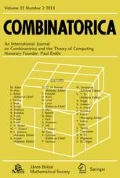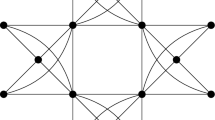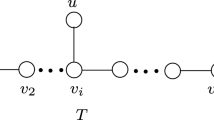Abstract
In this paper, we present several density-type theorems which show how to find a copy of a sparse bipartite graph in a graph of positive density. Our results imply several new bounds for classical problems in graph Ramsey theory and improve and generalize earlier results of various researchers. The proofs combine probabilistic arguments with some combinatorial ideas. In addition, these techniques can be used to study properties of graphs with a forbidden induced subgraph, edge intersection patterns in topological graphs, and to obtain several other Ramsey-type statements.
Similar content being viewed by others
References
N. Alon: Subdivided graphs have linear Ramsey numbers, J. Graph Theory 18 (1994), 343–347.
N. Alon, R. A. Duke, H. Lefmann, V. Rödl and R. Yuster: The algorithmic aspects of the regularity lemma, J. Algorithms 16 (1994), 80–109.
N. Alon, M. Krivelevich and B. Sudakov: Turán numbers of bipartite graphs and related Ramsey-type questions, Combin. Probab. Comput. 12 (2003), 477–494.
N. Alon, J. Pach and J. Solymosi: Ramsey-type theorems with forbidden subgraphs, Combinatorica 21(2) (2001), 155–170.
N. Alon and J. H. Spencer: The probabilistic method, 2nd ed., Wiley, 2000.
J. Beck: An upper bound for diagonal Ramsey numbers, Studia Sci. Math. Hungar. 18 (1983), 401–406.
B. Bollobás and A. Thomason: Proof of a conjecture of Mader, Erdős and Hajnal on topological complete subgraphs; European J. Combin. 19 (1998), 883–887.
S. A. Burr and P. Erdős: On the magnitude of generalized Ramsey numbers for graphs, in: Infinite and Finite Sets I, 10, Colloq. Math. Soc. János Bolyai, North-Holland, Amsterdam, 1975, 214–240.
G. Cairns and Y. Nikolayevsky: Bounds for generalized thrackles, Discrete Comput. Geom. 23 (2000), 191–206.
G. Chen and R. H. Schelp: Graphs with linearly bounded Ramsey numbers, J. Combin. Theory Ser. B 57 (1993), 138–149.
V. Chvátal, V. Rödl, E. Szemerédi and W. T. Trotter, Jr.: The Ramsey number of a graph with bounded maximum degree, J. Combin. Theory Ser. B 34 (1983), 239–243.
M. Chudnovsky and S. Safra: The Erdős-Hajnal conjecture for bull-free graphs, J. Combin. Theory Ser. B 98 (2008), 1301–1310.
D. Conlon: A new upper bound for diagonal Ramsey numbers, Ann. of Math. 170 (2009), to appear.
R. Diestel: Graph theory, 2nd ed., Springer, 1997.
N. Eaton: Ramsey numbers for sparse graphs, Discrete Math. 185, 63–75.
P. Erdős: Some remarks on the theory of graphs, Bull. Amer. Math. Soc. 53 (1947), 292–294.
P. Erdős: Problems and results in graph theory and combinatorial analysis, in: Graph theory and related topics (Proc. Conf. Waterloo, 1977), Academic Press, New York (1979), 153–163.
P. Erdős and A. Hajnal: Ramsey-type theorems, Discrete Appl. Math. 25 (1989), 37–52.
P. Erdős, A. Hajnal and J. Pach: Ramsey-type theorem for bipartite graphs, Geombinatorics 10 (2000), 64–68.
P. Erdős and G. Szekeres: A combinatorial problem in geometry, Compositio Math. 2 (1935), 463–470.
J. Fox: There exist graphs with super-exponential Ramsey multiplicity constant, J. Graph Theory 57 (2008), 89–98.
J. Fox and J. Pach: Separator theorem and Turán-type results for planar intersection graphs, Adv. Math. 219 (2008), 1070–1080.
J. Fox and B. Sudakov: Induced Ramsey-type theorems, Adv. Math. 219 (2008), 1771–1800.
J. Fox and B. Sudakov: Two remarks on the Burr-Erdős conjecture, European J. Combin., to appear.
W. T. Gowers: A new proof of Szemerédi’s theorem for arithmetic progressions of length four, Geom. Funct. Anal. 8 (1998), 529–551.
R. Graham, V. Rödl and A. Ruciński: On graphs with linear Ramsey numbers, J. Graph Theory 35 (2000), 176–192.
R. Graham, V. Rődl and A. Ruciński: On bipartite graphs with linear Ramsey numbers, Combinatorica 21(2) (2001), 199–209.
R. Graham, B. Rothschild and J. Spencer: Ramsey theory, 2nd ed., Wiley, New York, 1990.
B. Green and T. Tao: The primes contain arbitrarily long arithmetic progressions, Annals of Math. 167 (2008), 481–547.
H. Hatami: Graph norms and Sidorenko’s conjecture, Israel Journal of Mathematics, to appear.
Y. Kohayakawa, H. Prömel and V. Rödl: Induced Ramsey numbers, Combinatorica 18(3) (1998), 373–404.
J. Komlós and M. Simonovits: Szemerédi’s regularity lemma and its applications in graph theory, in: Combinatorics, Paul Erdős is eighty, Vol. 2 (Keszthely, 1993), 295–352, Bolyai Soc. Math. Stud., 2, Jnos Bolyai Math. Soc., Budapest, 1996.
J. Komlós and E. Szemerédi: Topological cliques in graphs II, Combin. Probab. Comput. 5 (1996), 79–90.
A. Kostochka and V. Rödl: On graphs with small Ramsey numbers, J. Graph Theory 37 (2001), 198–204.
A. Kostochka and V. Rödl: On graphs with small Ramsey numbers II, Combinatorica 24(3) (2004), 389–401.
A. Kostochka and V. Rödl: On Ramsey numbers of uniform hypergraphs with given maximum degree, J. Combin. Theory Ser. A 113 (2006), 1555–1564.
A. Kostochka and B. Sudakov: On Ramsey numbers of sparse graphs, Combin. Probab. Comput. 12 (2003), 627–641.
T. Kővári, V. T. Sós and P. Turán: On a problem of K. Zarankiewicz, Colloq Math. 3 (1954), 50–57.
M. Krivelevich and B. Sudakov: Pseudo-random graphs, in: More Sets, Graphs and Numbers, Bolyai Society Mathematical Studies 15, Springer, 2006, 199–262.
L. Lovász, J. Pach and M. Szegedy: On Conway’s thrackle conjecture, Discrete Comput. Geom. 18 (1997), 369–376.
V. Nikiforov: Edge distribution of graphs with few copies of a given graph, Combin. Probab. Comput. 15 (2006), 895–902.
J. Pach and J. Solymosi: Crossing patterns of segments, J. Combin. Theory Ser. A 96 (2001), 316–325.
J. Pach and G. Tóth: Disjoint edges in topological graphs, in: Combinatorial Geometry and Graph Theory (J. Akiyama et al., eds.), Lecture Notes in Computer Science 3330, Springer-Verlag, Berlin, 2005, 133–140.
F. P. Ramsey: On a problem of formal logic, Proc. London Math. Soc. 30 (1930), 264–286.
V. Rödl: On universality of graphs with uniformly distributed edges, Discrete Math. 59 (1986), 125–134.
L. Shi: Cube Ramsey numbers are polynomial, Random Structures & Algorithms 19 (2001), 99–101.
A. F. Sidorenko: A correlation inequality for bipartite graphs, Graphs Combin. 9 (1993), 201–204.
M. Simonovits: Extremal graph problems, degenerate extremal problems and supersaturated graphs; in: Progress in graph theory (J. A. Bondy ed.), Academic, New York, 1984, 419–437.
B. Sudakov: Few remarks on the Ramsey-Turán-type problems, J. Combin. Theory Ser. B 88 (2003), 99–106.
B. Sudakov: Large K r-free subgraphs in K s-free graphs and some other Ramsey-type problems, Random Structures & Algorithms 26 (2005), 253–265.
E. Szemerédi: On sets of integers containing no k elements in arithmetic progression, Acta Arithmetica 27 (1975), 199–245.
A. Thomason: A disproof of a conjecture of Erdős in Ramsey theory, J. Lond. Math. Soc. 39 (1989), 246–255.
B. L. van der Waerden: Beweis einer Baudet’schen Vermutung, Nieuw. Arch. Wisk. 15 (1927), 212–216.
Author information
Authors and Affiliations
Corresponding author
Additional information
Research supported by an NSF Graduate Research Fellowship and a Princeton Centennial Fellowship.
Research supported in part by NSF CAREER award DMS-0812005 and by USA-Israeli BSF grant.
Rights and permissions
About this article
Cite this article
Fox, J., Sudakov, B. Density theorems for bipartite graphs and related Ramsey-type results. Combinatorica 29, 153–196 (2009). https://doi.org/10.1007/s00493-009-2475-5
Received:
Published:
Issue Date:
DOI: https://doi.org/10.1007/s00493-009-2475-5




